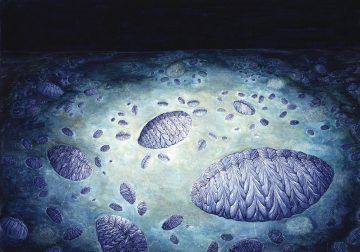Traci Watson in Nature:
 The revolutionary animal lived and died in the muck. In its final hours, it inched across the sea floor, leaving a track like a tyre print, and finally went still. Then geology set to work. Over the next half a billion years, sediment turned to stone, preserving the deathbed scene. The fossilized creature looks like a piece of frayed rope measuring just a few centimetres wide. But it was a trailblazer among living things. This was the earliest-known animal to show unequivocal evidence of two momentous innovations packaged together: the ability to roam the ocean floor, and a body built from segments. It was also among the oldest known to have clear front and back ends, and a left side that mirrored its right. Those same features are found today in animals from flies to flying foxes, from lobsters to lions.
The revolutionary animal lived and died in the muck. In its final hours, it inched across the sea floor, leaving a track like a tyre print, and finally went still. Then geology set to work. Over the next half a billion years, sediment turned to stone, preserving the deathbed scene. The fossilized creature looks like a piece of frayed rope measuring just a few centimetres wide. But it was a trailblazer among living things. This was the earliest-known animal to show unequivocal evidence of two momentous innovations packaged together: the ability to roam the ocean floor, and a body built from segments. It was also among the oldest known to have clear front and back ends, and a left side that mirrored its right. Those same features are found today in animals from flies to flying foxes, from lobsters to lions.
Palaeontologist Shuhai Xiao marvels at the tracks left by this creature, Yilingia spiciformis, and how they captured evidence of its movement. In his cluttered office at Virginia Tech in Blacksburg, he shows off a slab of beige resin — a reproduction of the fossil, which was found in China’s Yangtze Gorges region and is now kept in a Chinese research institute. The replica captures a snapshot of a moment from 550 million years ago. Xiao, whose team formally described Yilingia last year1, traces the bumpy tracks it made immediately before its death. “It was just moving around, and it died suddenly,” he says.
More here.
